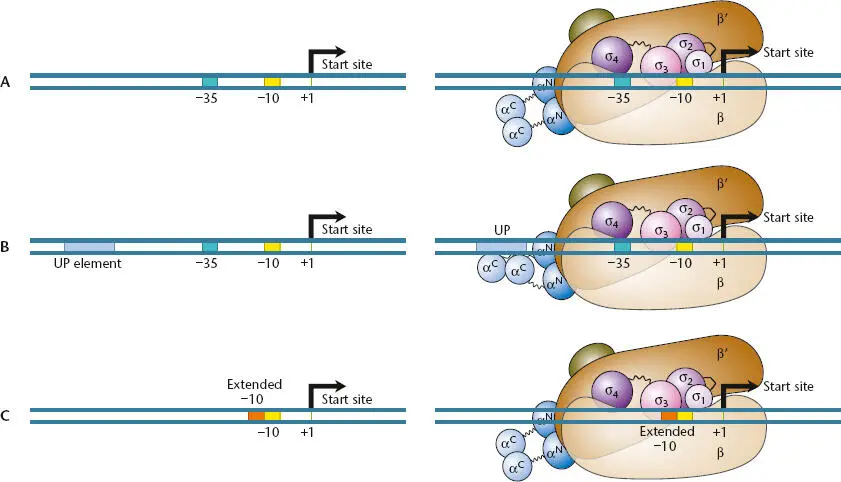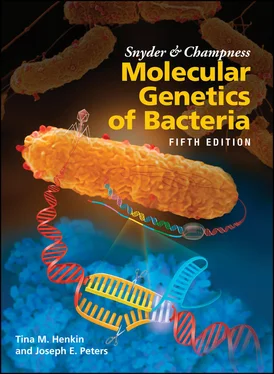
Figure 2.10 Interactions between RNA polymerase subunits and promoter elements. (A)Interaction of σ 70at –10 and –35 regions. (B)Flexible linkers between the α subunit carboxyl-terminal domain (αCTD) and the amino-terminal domain of α (αNTD) domains allow binding of αCTDs to UP elements in the DNA. (C)σ 3binding to an extended –10 region. Modified from Dove SL, Hochschild A, in Higgins NP (ed), The Bacterial Chromosome (ASM Press, Washington, DC, 2005).
TERMINATION OF TRANSCRIPTION
Once the RNA polymerase has initiated transcription at a promoter, it continues along the DNA, polymerizing ribonucleotides into a growing RNA chain, until it encounters a transcription terminationsignal. These termination sites are not necessarily at the ends of each individual gene. In bacteria, more than one gene is often transcribed into a single RNA, so a transcription termination site does not occur until the end of the cluster of genes that are transcribed together. Even if only a single gene is being transcribed, the transcription termination site may occur far downstream of the protein-coding region of the gene.
Bacterial RNA polymerase responds to two basic types of transcription termination signals, designated factor-independent(or intrinsic) and factor-dependentterminators (see Washburn and Gottesman, Suggested Reading). As their names imply, these types are distinguished by whether they work with just RNA polymerase and DNA alone or need other factors before they can terminate transcription. Both types of termination signal require participation of the newly transcribed RNA to promote termination, which means that RNA polymerase must transcribe the terminator region before termination can occur.
Factor-Independent Termination
A typical factor-independent (or intrinsic) transcription terminator, shown in Figure 2.14, consists of two parts. The first is an inverted repeat. When an inverted-repeat DNA sequence is transcribed into RNA, the RNA can form a hairpin because the two parts of the repeat are complementary to each other. The inverted repeat is followed by a short string of A’s in the template strand, which results in synthesis of a series of U’s in the RNA. Transcription usually terminates somewhere in the string of A’s in the DNA, leaving a string of U’s at the 3′ end of the RNA terminated using this mechanism.
Although the details of the process remain under study, the different elements of the terminator work together to promote termination. The transcription of the U-rich RNA from the A-rich template causes the RNA polymerase to pause, which allows time for the GC-rich hairpin to form in the emerging RNA transcript. The hairpin structure then causes the RNA polymerase to be released by an unknown mechanism, but it is likely to involve hairpin-induced conformational changes and destabilization of the DNA-RNA hybrid, which is facilitated by the fact that the AU base pairs that form in the DNA-RNA hybrid are less stable than a normal DNA-RNA that includes GC base pairs. RNA polymerase releases the RNA transcript and the DNA, terminating transcription, and the released transcript contains the hairpin structure at its 3´ end.
BOX 2.1
Antibiotic Inhibitors of Transcription
Some of the components of the transcription apparatus are the targets of antibiotics used in the treatment of bacterial infections and in tumor therapy. Some of these antibiotics are made by soil bacteria and fungi, and some have been synthesized chemically.
Inhibitors of rNTP Synthesis
Some antibiotics that inhibit transcription do so by inhibiting the synthesis of the rNTPs. An example is azaserine, which inhibits purine biosynthesis. Azaserine and other antibiotics that block the synthesis of the ribonucleotides are usually not specific to transcription, since the ribonucleotides, including ATP and GTP, have many other uses in the cell. This lack of specificity limits the usefulness of these antibiotics for studying transcription, although some of them have other uses.
Inhibitors of Transcription Initiation
Rifamycin and its more commonly used derivative, rifampin, block transcription by binding to the β subunit of RNA polymerase and specifically blocking the initiation of RNA synthesis. The antibiotic binds in the active-site channel of RNA polymerase and limits growth of the RNA chain to a few nucleotides. The property of blocking only transcription initiation has made these antibiotics very useful in the study of transcription. For example, they have been used to analyze the steps in initiation of RNA synthesis and to study the stability of RNA in the cell. These antibiotics are useful therapeutic agents in the treatment of tuberculosis and other difficult-to-treat bacterial infections because they inhibit the RNA polymerases of essentially all types of bacteria, but not the RNA polymerases of eukaryotes, so they are not toxic to humans and animals. Accordingly, many derivatives have been made from them.
In rifampin-resistant mutants, one or more amino acids in the β subunit of RNA polymerase lining the active-site channel have been changed so that rifampin can no longer bind but the RNA polymerase still functions. Chromosomal mutations that confer resistance to rifampin are fairly common and have limited the usefulness of these antibiotics somewhat.
Inhibitors of RNA Elongation and Termination
Streptolydigin also binds to the β subunit of the RNA polymerase of bacteria but can block RNA synthesis after it is under way. It has a weaker affinity for RNA polymerase than does rifampin, so it blocks transcription only when added at higher concentrations, which limits its usefulness. Bicyclomycin targets the transcription terminator protein ρ and prevents ρ-dependent transcription termination (but not factor-independent transcription termination). Use of bicyclomycin as an antibiotic depends on the importance of ρ-dependent transcription termination in the target organism.
Inhibitors that Affect the DNA Template
Actinomycin D and bleomycin block transcription by binding to the DNA. After bleomycin binds, it also nicks the DNA. While such drugs have been useful for studying transcription in bacteria, they are not very useful in antibacterial therapy because they are not specific to bacteria and are very toxic to humans and animals. They are, however, used in antitumor therapy.
Factor-Dependent Termination
While factor-independent terminators are easily recognizable, the factor-dependent transcription terminators have very little sequence in common with each other and therefore are not readily apparent. The major termination factor in E. coli is called Rho (ρ). The ρ factor can be found in most types of bacteria, and this type of termination is likely to be widely conserved.
Any model for how the ρ factor terminates transcription at ρ-dependent termination sites has to incorporate the following facts. First, ρ usually causes the termination of RNA synthesis only if the RNA is not being translated. In bacteria, which lack a nuclear membrane, translation can begin on a nascent RNA before transcription is complete (see the introduction). Second, ρ is an RNA-dependent ATPase that cleaves ATP to get energy, but its ATPase activity is dependent on the presence of RNA. Finally, ρ is also an RNA-DNA helicase. It is similar to the DNA helicases that separate the strands of DNA during replication, but it unwinds only a double helix with RNA in one strand and DNA in the other.
Читать дальше












